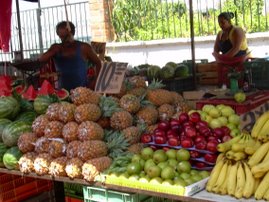The village of Ajijic is the center of the expatriate population on Lake Chapala, although hardly the only village around the Lake Chapala and Guadalajara area where many Americans, Canadians and Europeans have settled. As you can see from the map, Ajijic is one of several towns on the north shore of Lake Chapala, Mexico's largest fresh water lake. The two closest towns, Chapala and Jocotepec have fewer Nortamericanos, but there is clearly more development headed in those directions. Chapala is much larger than Ajijic, and Mexicans have come for years to vacation at its lake front.
Ajijic has been the center of expartiate settlement in this area for decades. It attracted a lot of artists and writers, and the village still feels this influence. There are many art galleries and shops. Tennessee Williams, Somerset Maugham, and D.H. Lawrence all lived and wrote in the Ajijic area.
The streets remain rough cobblestone, except for the "Carretera" which runs between the towns. The population of Ajijic is estimated at about 15,000, with about 3-4,000 full time expatriate residents. Even though the expatriate residents have brought money into the area, and driven prices up, many of the Mexican families have stayed in Ajijic. In fact, Mexicans are probably drawn to the area because of the work opportunities created by the influx of "gringos." By the way, the term gringo first came as a nickname for the American soldiers who occupied Mexico during the Mexican American war and was, of course, a pejorative term. Today, the term appears to be more neutral; we hear Mexicans refer to their "gringo friends" and well as "dumb, arrogant gringos," a moniker we are trying to avoid!
The village is dominated by the lake on the south side, and beautiful mountains on the north side. The north, or mountain side, of the Carretera, was, until recently undeveloped. The lake side contains the old village. The mountain side has now been developed with a number of gated communities designed exclusively for gringo retirees. These homeowners, building up the mountainside, have beautiful lake views, but live isolated from their Mexican neighbors.
We live on the west side of Ajijic, on the lake side, an area that is primarily Mexican. Many Guadaljarans own lakeside cottages on the lake. Our casita is in a group of six such cottages which have been owned for use on weekends. Four of these are owned by Mexicans and the other two by gringos, one of which we rent. Saturday night when we came back from dinner to celebrate our 33rd anniversary, a family of Mexicans in one of the other cottages invited us to visit with them. We enjoyed their company and had a good opportunity to work on our Spanish; they spoke very little English.
As you might imagine, there is quite a bit of building going on in Ajijic. Most of it is being done by hand, very slowly. The overall sense you get when walking or driving around the area is that people everywhere are selling food, crafts, and just about anything they can make pesos with. I think Mexicans love to eat, and there are opportunities everywhere to find food. Many families own small tiendas, or shops, which are very tiny and sell food, clothes, beer, tortillas, or other useful items. They live in the back, and it provides the family with an income. The Caraterra is full of businesses and restaurants and has a bit of a chaotic feel to it. Mexico is not a quiet place! There is litter and graffiti. They don't seem to have any zoning or development laws here. You might see a nice new restaurant next to an empty lot with goats, next to an auto repair shop, next to a boutique. But it is full of people of all types living their lives, peacefully and courteously.
Overall, Ajijic is an interesting mix of pure Mexican life and gringo amenities. We often see our Mexican neighbors riding horses through town, herding cows down by the lake, or cooking corn to sell on their front stoop, while, at the same time, the town has at least 50 restaurants of all types and prices, wireless high speed internet access, cable and satellite TV, and many other services the gringo retirees seek.
I do worry about where this is all headed, as more boomers retire here, which is one reason we are renting here instead of buying. But, for now, it's a very pleasant combination of authentic Mexican culture, comfortable living, stupendous lake and mountain views, tropical birds and, of course, beautiful weather.
Saturday, June 9, 2007
Subscribe to:
Post Comments (Atom)



































































No comments:
Post a Comment